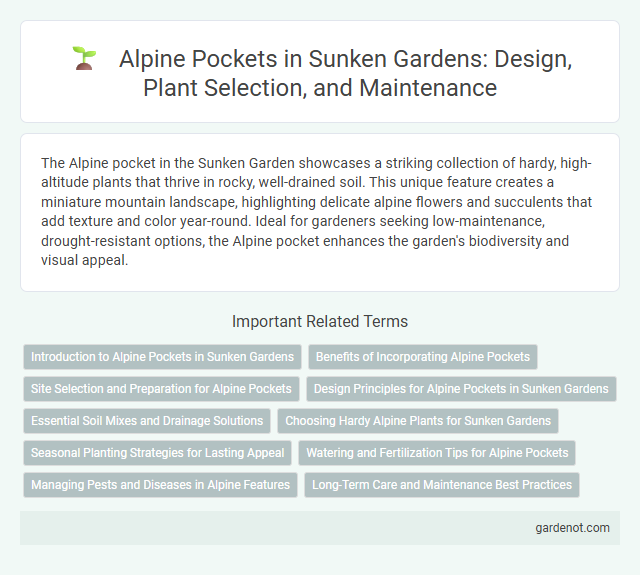The Alpine pocket in the Sunken Garden showcases a striking collection of hardy, high-altitude plants that thrive in rocky, well-drained soil. This unique feature creates a miniature mountain landscape, highlighting delicate alpine flowers and succulents that add texture and color year-round. Ideal for gardeners seeking low-maintenance, drought-resistant options, the Alpine pocket enhances the garden's biodiversity and visual appeal.
Introduction to Alpine Pockets in Sunken Gardens
Alpine pockets in Sunken Gardens are specialized miniature rock gardens designed to mimic high-altitude environments, featuring drought-tolerant and cold-hardy plants. These pockets showcase diverse species such as saxifrages, edelweiss, and alpine sedums, thriving in well-drained, rocky soil with minimal nutrients. Carefully arranged stones create natural microclimates that support plant growth and demonstrate ecological adaptation in compact garden spaces.
Benefits of Incorporating Alpine Pockets
Incorporating alpine pockets into sunken gardens enhances biodiversity by providing specialized microhabitats for alpine plants and small wildlife. These pockets improve soil drainage and moisture retention, supporting plant health and reducing maintenance needs. Integrating alpine pockets also creates visual interest through varied textures and seasonal blooms, enriching the overall garden aesthetic.
Site Selection and Preparation for Alpine Pockets
Selecting a well-drained, rocky area with plenty of sunlight is crucial for creating an Alpine pocket in a sunken garden, ensuring optimal root health and growth. Preparing the site involves digging a recessed bed with excellent drainage, incorporating gritty soil mixtures with sand and gravel to mimic alpine conditions. Strategic placement among larger rocks enhances microclimate stability and protects delicate alpine plants from excessive moisture and temperature fluctuations.
Design Principles for Alpine Pockets in Sunken Gardens
Alpine pockets in sunken gardens emphasize naturalistic design principles, integrating rugged stone arrangements with low-growing, drought-tolerant alpine plants to mimic mountainous habitats. Careful attention to soil drainage, microclimates, and layering of textures ensures optimal plant health and aesthetic appeal. Strategic placement enhances visual depth while supporting biodiversity within the sunken garden environment.
Essential Soil Mixes and Drainage Solutions
Alpine pocket plantings thrive in essential soil mixes composed of gritty, well-draining substrates such as sand, perlite, and small gravel to prevent water retention and root rot. Implementing drainage solutions like layered coarse materials and sloped beds ensures excess moisture swiftly drains away, mimicking natural mountainous environments. Optimal soil aeration and moisture control are critical for maintaining healthy alpine species in sunken garden settings.
Choosing Hardy Alpine Plants for Sunken Gardens
Selecting hardy alpine plants for sunken gardens involves prioritizing species like Sempervivum, Saxifraga, and Dianthus, known for their resilience in rocky, well-drained soils. These plants thrive in the unique microclimate of sunken gardens, offering exceptional drought tolerance and cold hardiness. Incorporating native alpine species enhances biodiversity and ensures low-maintenance growth tailored to the challenging terrain.
Seasonal Planting Strategies for Lasting Appeal
In the Sunken Garden's Alpine Pocket, strategic seasonal planting ensures year-round visual interest by incorporating resilient alpine species that thrive in changing climates. Focus on early-blooming spring bulbs, summer-flowering perennials, and frost-hardy evergreen ground covers to maintain color and texture throughout the seasons. Carefully timed rotations and soil amendments support plant health and prolonged garden appeal, attracting pollinators and enhancing biodiversity.
Watering and Fertilization Tips for Alpine Pockets
Alpine pockets thrive with well-drained soil that retains moisture without waterlogging, making regular but moderate watering essential to mimic their natural mountain habitats. Balanced fertilization using a low-nitrogen, high-phosphorus formula encourages robust root development and vibrant blooms, applied sparingly during the growing season. Avoid overwatering and excessive fertilization to prevent root rot and nutrient burn in these delicate alpine plantings.
Managing Pests and Diseases in Alpine Features
Effective management of pests and diseases in alpine pocket features involves regular monitoring for common threats such as aphids, spider mites, and fungal infections like powdery mildew. Utilizing organic insecticides, promoting beneficial insects, and ensuring proper air circulation helps maintain plant health and prevents infestations. Implementing these integrated pest management strategies supports the resilience and longevity of alpine plant collections within sunken gardens.
Long-Term Care and Maintenance Best Practices
Alpine pockets in sunken gardens require consistent long-term care focusing on well-drained soil and periodic pruning to maintain plant health and aesthetics. Implementing a scheduled maintenance plan involving soil amendments and monitoring for pests ensures sustainability and vibrancy. Proper irrigation techniques tailored to alpine species prevent root rot and promote longevity.
Alpine pocket Infographic

 gardenot.com
gardenot.com